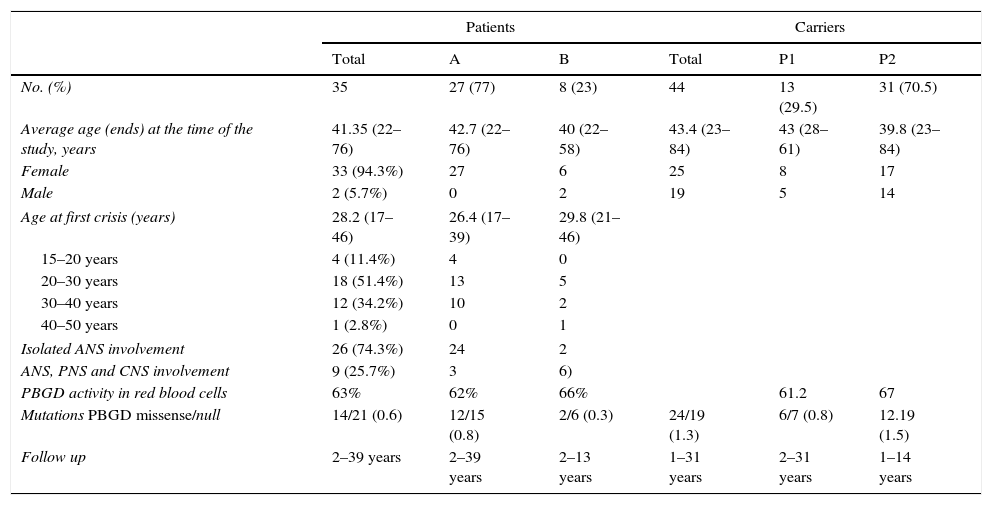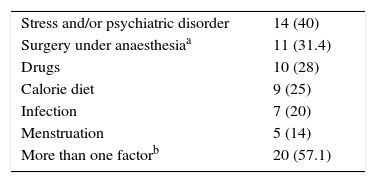Acute intermittent porphyria (AIP) is a rare disease that results from a deficiency of porphobilinogen deaminase, the third enzyme of the heme biosynthetic pathway. AIP carriers are at risk of presenting acute neurovisceral attacks associated with overproduction of heme-precursors in the liver.
Patients and methodWe report the characteristics of all AIP patients attended in the Hospital Clinic of Barcelona during the years 1993–2013 and their long-term follow-up.
ResultsThirty-five AIP patients (33 women, 2 men) experienced acute attacks. Treatment with hemin resolved the acute neurovisceral crisis in all cases. Nine patients presented peripheral neuropathy and persistent sequelae. Long-term follow-up allowed classifying the patients into groups: A, patients with acute symptoms during 1–2 years and subsequent long-lasting clinical remission (n=24) or a few sporadic crises (n=3), and B, patients with recurrent attacks requiring chronic administration of hemin (n=8). In a majority of the patients of group A, the urinary excretion of heme-precursors decreased gradually over time. However, the chronic hemin regime did not induce a decline of urinary heme-precursors in the patients of group B. Additionally, we identified 44 asymptomatic AIP carriers, most (70.5%) with normal values of heme-precursors in urine.
ConclusionsA majority of the AIP patients of our series achieved a long-lasting clinical remission. A minority (23%) presented recurrent attacks that required chronic hemin infusions without feasible interruption and without long-term biochemical remission. The type of mutation within the porphobilinogen deaminase gene and also life-style related factors may determine remission time-course.
La porfiria aguda intermitente (PAI) es una enfermedad causada por un defecto en la enzima porfobilinógeno deaminasa que cataliza la tercera etapa de síntesis del hemo. Los portadores pueden presentar ataques neuroviscerales agudos tras sobreproducción hepática de precursores del hemo.
Pacientes y métodoSe presentan las características de todos los pacientes con PAI atendidos en el Hospital Clínic de Barcelona entre los años 1993-2013, y su seguimiento a largo plazo.
ResultadosTreinta y cinco pacientes con PAI (33 mujeres y 2 varones) presentaron ataques agudos neuroviscerales. El tratamiento con hemina resolvió el cuadro agudo en todos los casos. Nueve pacientes presentaron polineuropatía y secuelas persistentes. El seguimiento permitió clasificar a los pacientes en: A, con sintomatología aguda durante 1-2 años y posterior remisión duradera (n=24) o bien alguna crisis puntual (n=3), y B, con ataques recurrentes que requirieron administración crónica de hemina (n=8). En la mayoría de los pacientes del grupo A la concentración urinaria de precursores del hemo fue disminuyendo progresivamente, mientras que en el grupo B esta se mantuvo elevada sin descenso observable a largo término. Adicionalmente, el estudio familiar permitió identificar 44 portadores asintomáticos, la mayoría (70,5%) con valores normales de precusores del hemo en orina.
ConclusionesUna mayoría de pacientes con PAI de nuestra serie logró una remisión clínica duradera. Una minoría presenta ataques recurrentes, sin que el tratamiento crónico con hemina haga factible su interrupción ni induzca remisión bioquímica a largo plazo. El tipo de mutación en el gen de la porfobilinógeno deaminasa, y también factores asociados al estilo de vida, pueden determinar el curso de la remisión.
Artículo
Comprando el artículo el PDF del mismo podrá ser descargado
Precio 19,34 €
Comprar ahora












